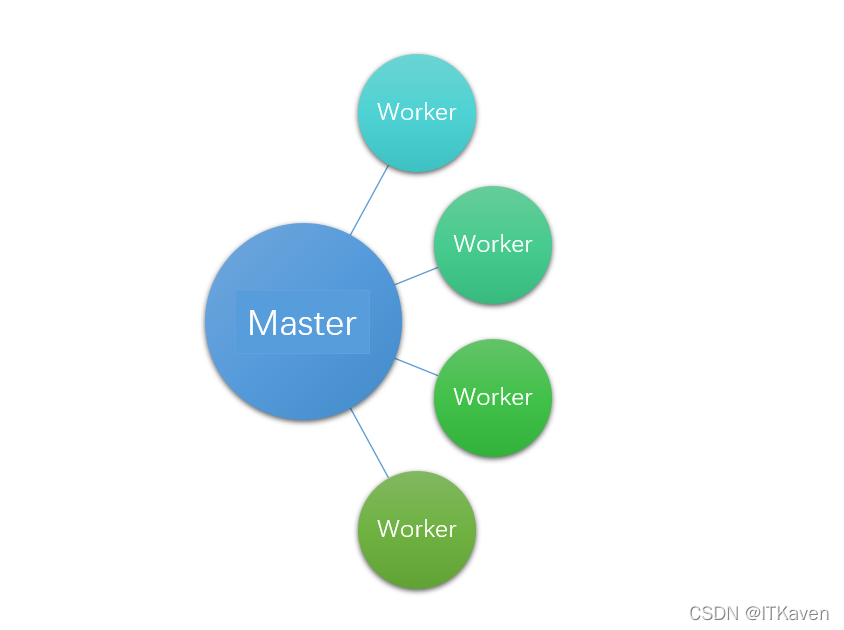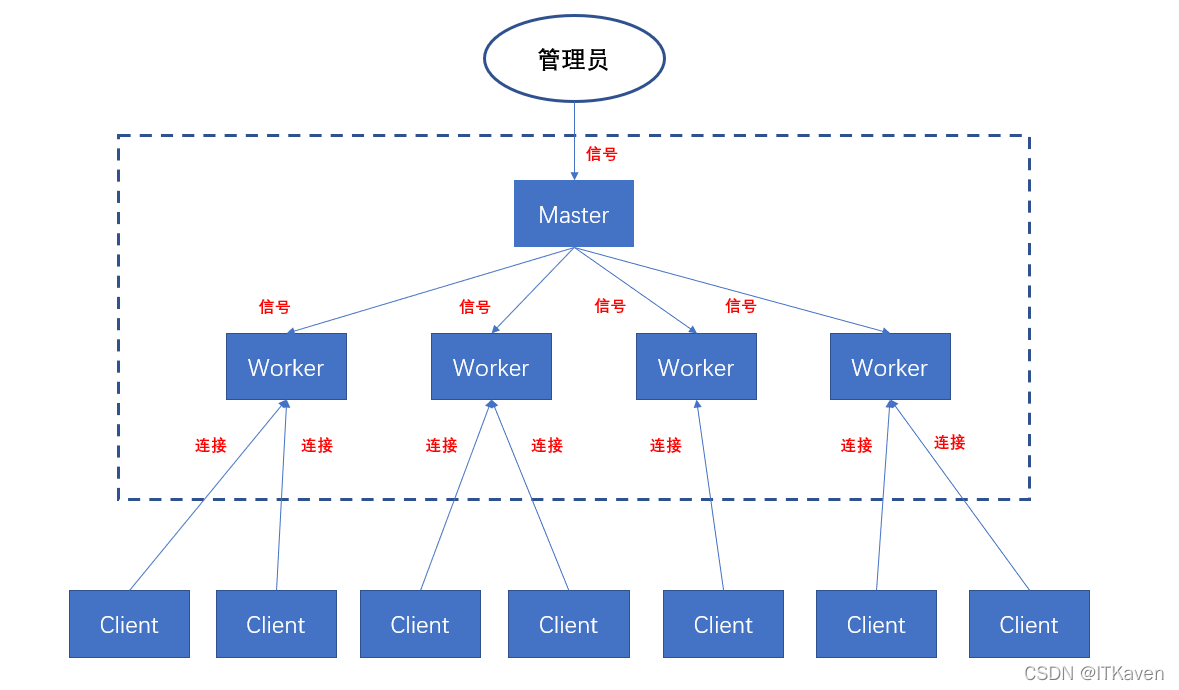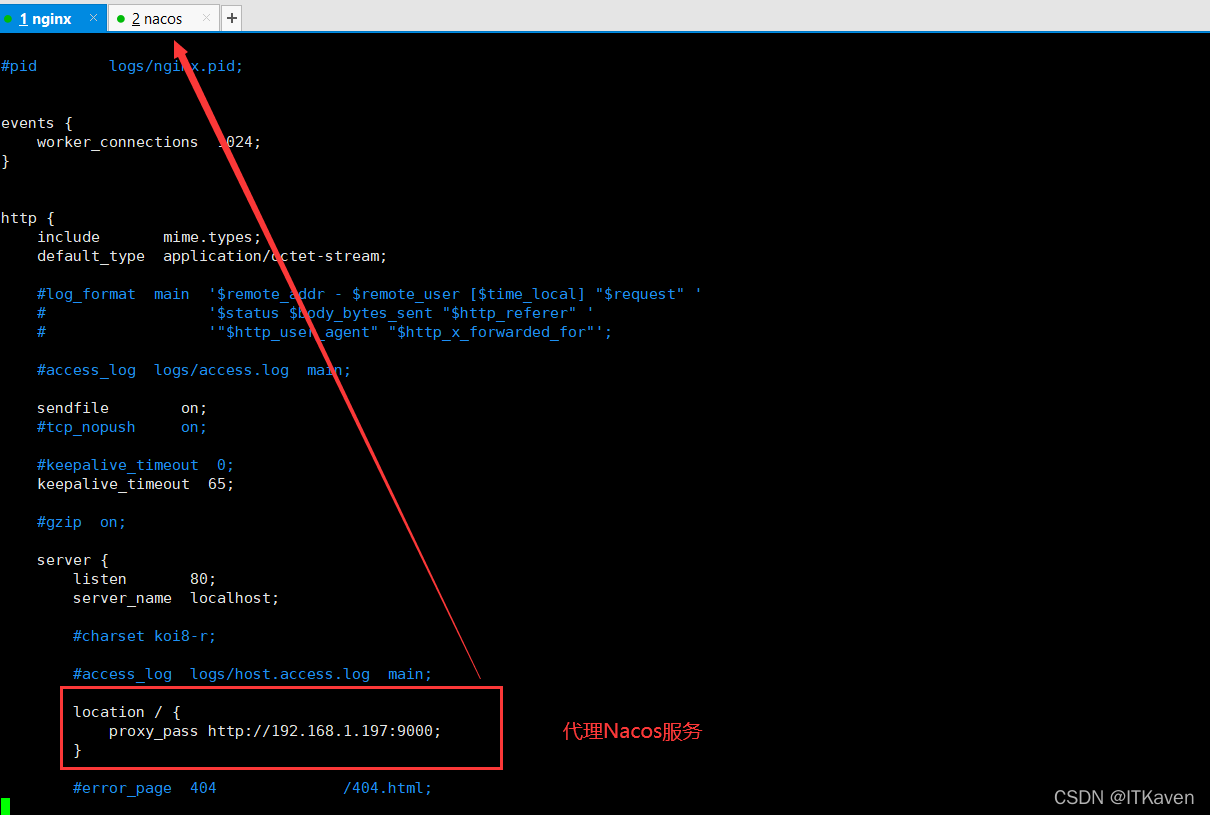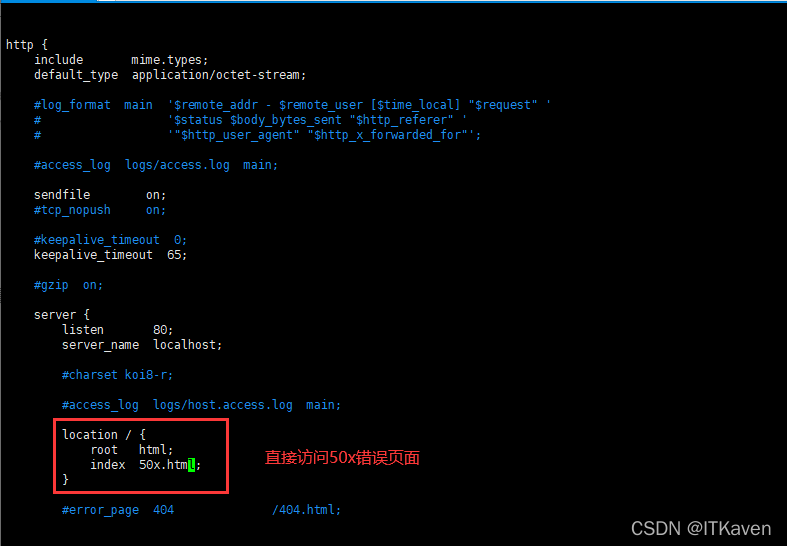How to implement Nginx hot deployment
Close the firewall so that the Nginx service can be accessed locally through the browser.
[root@localhost ~]# systemctl stop firewalld

Semaphore
View semaphore:
[root@localhost ~]# kill -l 1) SIGHUP 2) SIGINT 3) SIGQUIT 4) SIGILL 5) SIGTRAP 6) SIGABRT 7) SIGBUS 8) SIGFPE 9) SIGKILL 10) SIGUSR1 11) SIGSEGV 12) SIGUSR2 13) SIGPIPE 14) SIGALRM 15) SIGTERM 16) SIGSTKFLT 17) SIGCHLD 18) SIGCONT 19) SIGSTOP 20) SIGTSTP 21) SIGTTIN 22) SIGTTOU 23) SIGURG 24) SIGXCPU 25) SIGXFSZ 26) SIGVTALRM 27) SIGPROF 28) SIGWINCH 29) SIGIO 30) SIGPWR 31) SIGSYS 34) SIGRTMIN 35) SIGRTMIN+1 36) SIGRTMIN+2 37) SIGRTMIN+3 38) SIGRTMIN+4 39) SIGRTMIN+5 40) SIGRTMIN+6 41) SIGRTMIN+7 42) SIGRTMIN+8 43) SIGRTMIN+9 44) SIGRTMIN+10 45) SIGRTMIN+11 46) SIGRTMIN+12 47) SIGRTMIN+13 48) SIGRTMIN+14 49) SIGRTMIN+15 50) SIGRTMAX-14 51) SIGRTMAX-13 52) SIGRTMAX-12 53) SIGRTMAX-11 54) SIGRTMAX-10 55) SIGRTMAX-9 56) SIGRTMAX-8 57) SIGRTMAX-7 58) SIGRTMAX-6 59) SIGRTMAX-5 60) SIGRTMAX-4 61) SIGRTMAX-3 62) SIGRTMAX-2 63) SIGRTMAX-1 64) SIGRTMAX
There are 64 kinds of semaphore, the following are several Commonly used semaphores:
SIGINT,SIGTERM: Quickly close.SIGQUIT: Graceful shutdown (gracefully shut down the process, that is, wait until the request is completed and then shut down).SIGHUP: Smooth restart, reload the configuration file (smooth restart, no need to restart the server after modifying the configuration file).SIGUSR1: Re-read the log file, which is more useful when cutting the log file.SIGUSR2: Smoothly upgrade the executable program, used whennginxis upgraded.SIGWINCH: Shut down the worker process gracefully.
Nginx hot deployment
Nginx is a multi-process, high-performance reverse proxy server, including a master process and multiple worker processes (the number of worker processes can be set through the worker_processes parameter in the nginx.conf configuration file, the default1), which can make full use of multi-core processors.

Default 1 worker processes.

And the master process and the worker process have a parent-child process relationship.

NginxThe working mode is multi-process, NginxThere will be a master## after startup #Processes and multiple worker processes (default 1), multiple worker child processes will listen to the master parent process listening port (Refer to the relationship between parent and child processes), handle requests in parallel. masterThe parent process is mainly used to manage the worker child process (manage the worker process that actually provides services, send signals to the worker process, monitor The running status of the worker process. When the worker process exits abnormally, a new worker process will be restarted) to read and verify the configuration information, The master process will not serve user requests, but user requests are processed by the worker process.
Nginx is controlled through semaphores, such as stopping and restarting Nginx. Semaphores are a mechanism for inter-process communication. The main process controls multiple worker sub-processes through semaphores.
 Now let’s demonstrate how
Now let’s demonstrate how
Nginx
Nginx Configuration file to simulate the upgrade of Nginx (first copy a copy).
[root@localhost ~]# cd /usr/local/nginx/conf/ [root@localhost conf]# ll 总用量 68 -rw-r--r--. 1 root root 1077 12月 20 20:24 fastcgi.conf -rw-r--r--. 1 root root 1077 12月 20 20:24 fastcgi.conf.default -rw-r--r--. 1 root root 1007 12月 20 20:24 fastcgi_params -rw-r--r--. 1 root root 1007 12月 20 20:24 fastcgi_params.default -rw-r--r--. 1 root root 2837 12月 20 20:24 koi-utf -rw-r--r--. 1 root root 2223 12月 20 20:24 koi-win -rw-r--r--. 1 root root 5231 12月 20 20:24 mime.types -rw-r--r--. 1 root root 5231 12月 20 20:24 mime.types.default -rw-r--r--. 1 root root 2656 12月 20 21:26 nginx.conf -rw-r--r--. 1 root root 2656 12月 20 20:24 nginx.conf.default -rw-r--r--. 1 root root 636 12月 20 20:24 scgi_params -rw-r--r--. 1 root root 636 12月 20 20:24 scgi_params.default -rw-r--r--. 1 root root 664 12月 20 20:24 uwsgi_params -rw-r--r--. 1 root root 664 12月 20 20:24 uwsgi_params.default -rw-r--r--. 1 root root 3610 12月 20 20:24 win-utf [root@localhost conf]# cp nginx.conf nginx_old.conf [root@localhost conf]# vim nginx.conf
Since the hot deployment of  Nginx
Nginx
http://192.168.1.199/ is still the original one Nginx page.
 View the process of
View the process of
Nginx
[root@localhost conf]# ps -ef | grep nginx root 14964 1 0 22:25 ? 00:00:00 nginx: master process ./nginx nobody 14965 14964 0 22:25 ? 00:00:00 nginx: worker process root 15016 1521 0 23:07 pts/0 00:00:00 grep --color=auto nginx
Send# to the master process ##SIGUSR2 signal allows Nginx to smoothly upgrade the executable program. You can see that Nginx has restarted a set of master processes and worker processes, and the new master process is the old master The child process of the process (through the inheritance relationship between parent and child processes, the new master process can easily inherit the related resources of the old master process). <div class="code" style="position:relative; padding:0px; margin:0px;"><pre class='brush:php;toolbar:false;'>[root@localhost conf]# kill -s SIGUSR2 14964
[root@localhost conf]# ps -ef | grep nginx
root 14964 1 0 22:25 ? 00:00:00 nginx: master process ./nginx
nobody 14965 14964 0 22:25 ? 00:00:00 nginx: worker process
root 15019 14964 0 23:18 ? 00:00:00 nginx: master process ./nginx
nobody 15020 15019 0 23:18 ? 00:00:00 nginx: worker process
root 15022 1521 0 23:19 pts/0 00:00:00 grep --color=auto nginx</pre><div class="contentsignin">Copy after login</div></div>And Nginx stores the old and new
files in the log directory (saves the ID of the old and new master processes) ). <div class="code" style="position:relative; padding:0px; margin:0px;"><pre class='brush:php;toolbar:false;'>[root@localhost conf]# ll ../logs
总用量 16
-rw-r--r--. 1 root root 2729 12月 20 23:20 access.log
-rw-r--r--. 1 root root 708 12月 20 23:18 error.log
-rw-r--r--. 1 root root 6 12月 20 23:18 nginx.pid
-rw-r--r--. 1 root root 6 12月 20 22:25 nginx.pid.oldbin
[root@localhost conf]# cat ../logs/nginx.pid
15019
[root@localhost conf]# cat ../logs/nginx.pid.oldbin
14964</pre><div class="contentsignin">Copy after login</div></div>Sends the SIGWINCH signal to the old
process, allowing the old master process to close the old worker process. <div class="code" style="position:relative; padding:0px; margin:0px;"><pre class='brush:php;toolbar:false;'>[root@localhost conf]# kill -s SIGWINCH 14964
[root@localhost conf]# ps -ef | grep nginx
root 14964 1 0 22:25 ? 00:00:00 nginx: master process ./nginx
root 15019 14964 0 23:18 ? 00:00:00 nginx: master process ./nginx
nobody 15020 15019 0 23:18 ? 00:00:00 nginx: worker process
root 15030 1521 0 23:27 pts/0 00:00:00 grep --color=auto nginx</pre><div class="contentsignin">Copy after login</div></div>Now visit http://192.168.1.199/, it will respond
.
When accessing  http://192.168.1.199/nacos
http://192.168.1.199/nacos
, you will access the
service .
如果升级版本没有问题,就可以给旧master进程发送SIGQUIT信号,让旧master进程关闭,这样就只剩下新master进程和新worker进程,实现了Nginx的热部署。
[root@localhost conf]# kill -s SIGQUIT 14964 [root@localhost conf]# ps -ef | grep nginx root 15019 1 0 23:18 ? 00:00:00 nginx: master process ./nginx nobody 15020 15019 0 23:18 ? 00:00:00 nginx: worker process root 15034 1521 0 23:31 pts/0 00:00:00 grep --color=auto nginx
如果升级版本有问题,需要回滚到之前的版本,就可以给旧master进程发送SIGHUP信号,因为博主重新进行了测试,所以进程号都变了,但很显然旧master进程重新创建了旧worker进程,并且进行版本升级的master和worker进程没有被关闭。
[root@localhost conf]# kill -s SIGHUP 15084 [root@localhost conf]# ps -ef | grep nginx root 15084 1 0 12月20 ? 00:00:00 nginx: master process ./nginx root 15106 15084 0 12月20 ? 00:00:00 nginx: master process ./nginx nobody 15107 15106 0 12月20 ? 00:00:00 nginx: worker process nobody 15131 15084 0 00:02 ? 00:00:00 nginx: worker process root 15141 1521 0 00:09 pts/0 00:00:00 grep --color=auto nginx
给新master进程发送SIGQUIT信号,让新master进程关闭,这样就只剩下旧master进程和新创建的旧worker进程,实现了回滚。
[root@localhost conf]# kill -s SIGQUIT 15106 [root@localhost conf]# ps -ef | grep nginx root 15084 1 0 12月20 ? 00:00:00 nginx: master process ./nginx nobody 15131 15084 0 00:02 ? 00:00:00 nginx: worker process root 15159 1521 0 00:25 pts/0 00:00:00 grep --color=auto nginx
回滚成功。

还需要对版本回滚(即博主这里的配置文件回滚,不然下次重启就会出问题)。
[root@localhost conf]# cp -f nginx_old.conf nginx.conf cp:是否覆盖"nginx.conf"? y
为什么给旧master进程发送SIGHUP信号,旧master进程重新创建的worker进程没有重新读取配置文件?下面是官方的说明:
Send the HUP signal to the old master process. The old master process will start new worker processes without re-reading the configuration. After that, all new processes can be shut down gracefully, by sending the QUIT signal to the new master process.
向旧
master进程发送SIGHUP信号。旧master进程将启动新worker进程,而无需重新读取配置。之后,通过向新master进程发送SIGQUIT信号,所有新进程都可以正常关闭。
如果不存在新进程的情况下(只有一组master、worker进程),修改配置文件,再向master进程发送SIGHUP信号,看是否会重新加载配置文件。

[root@localhost conf]# kill -s SIGHUP 15084
很显然配置文件被重新加载了,由于博主还没有看源码,只能猜测Nginx的实现(如果说错了,请大家评论补充),Nginx应该是根据当前是否在进行热部署(存在新master进程),来决定SIGHUP信号是否需要重新加载配置文件。

The above is the detailed content of How to implement Nginx hot deployment. For more information, please follow other related articles on the PHP Chinese website!

Hot AI Tools

Undresser.AI Undress
AI-powered app for creating realistic nude photos

AI Clothes Remover
Online AI tool for removing clothes from photos.

Undress AI Tool
Undress images for free

Clothoff.io
AI clothes remover

Video Face Swap
Swap faces in any video effortlessly with our completely free AI face swap tool!

Hot Article

Hot Tools

Notepad++7.3.1
Easy-to-use and free code editor

SublimeText3 Chinese version
Chinese version, very easy to use

Zend Studio 13.0.1
Powerful PHP integrated development environment

Dreamweaver CS6
Visual web development tools

SublimeText3 Mac version
God-level code editing software (SublimeText3)

Hot Topics
 1387
1387
 52
52
 How to configure cloud server domain name in nginx
Apr 14, 2025 pm 12:18 PM
How to configure cloud server domain name in nginx
Apr 14, 2025 pm 12:18 PM
How to configure an Nginx domain name on a cloud server: Create an A record pointing to the public IP address of the cloud server. Add virtual host blocks in the Nginx configuration file, specifying the listening port, domain name, and website root directory. Restart Nginx to apply the changes. Access the domain name test configuration. Other notes: Install the SSL certificate to enable HTTPS, ensure that the firewall allows port 80 traffic, and wait for DNS resolution to take effect.
 How to start nginx server
Apr 14, 2025 pm 12:27 PM
How to start nginx server
Apr 14, 2025 pm 12:27 PM
Starting an Nginx server requires different steps according to different operating systems: Linux/Unix system: Install the Nginx package (for example, using apt-get or yum). Use systemctl to start an Nginx service (for example, sudo systemctl start nginx). Windows system: Download and install Windows binary files. Start Nginx using the nginx.exe executable (for example, nginx.exe -c conf\nginx.conf). No matter which operating system you use, you can access the server IP
 How to check nginx version
Apr 14, 2025 am 11:57 AM
How to check nginx version
Apr 14, 2025 am 11:57 AM
The methods that can query the Nginx version are: use the nginx -v command; view the version directive in the nginx.conf file; open the Nginx error page and view the page title.
 How to check the name of the docker container
Apr 15, 2025 pm 12:21 PM
How to check the name of the docker container
Apr 15, 2025 pm 12:21 PM
You can query the Docker container name by following the steps: List all containers (docker ps). Filter the container list (using the grep command). Gets the container name (located in the "NAMES" column).
 How to run nginx apache
Apr 14, 2025 pm 12:33 PM
How to run nginx apache
Apr 14, 2025 pm 12:33 PM
To get Nginx to run Apache, you need to: 1. Install Nginx and Apache; 2. Configure the Nginx agent; 3. Start Nginx and Apache; 4. Test the configuration to ensure that you can see Apache content after accessing the domain name. In addition, you need to pay attention to other matters such as port number matching, virtual host configuration, and SSL/TLS settings.
 How to check whether nginx is started
Apr 14, 2025 pm 01:03 PM
How to check whether nginx is started
Apr 14, 2025 pm 01:03 PM
How to confirm whether Nginx is started: 1. Use the command line: systemctl status nginx (Linux/Unix), netstat -ano | findstr 80 (Windows); 2. Check whether port 80 is open; 3. Check the Nginx startup message in the system log; 4. Use third-party tools, such as Nagios, Zabbix, and Icinga.
 How to create a mirror in docker
Apr 15, 2025 am 11:27 AM
How to create a mirror in docker
Apr 15, 2025 am 11:27 AM
Steps to create a Docker image: Write a Dockerfile that contains the build instructions. Build the image in the terminal, using the docker build command. Tag the image and assign names and tags using the docker tag command.
 How to start containers by docker
Apr 15, 2025 pm 12:27 PM
How to start containers by docker
Apr 15, 2025 pm 12:27 PM
Docker container startup steps: Pull the container image: Run "docker pull [mirror name]". Create a container: Use "docker create [options] [mirror name] [commands and parameters]". Start the container: Execute "docker start [Container name or ID]". Check container status: Verify that the container is running with "docker ps".




